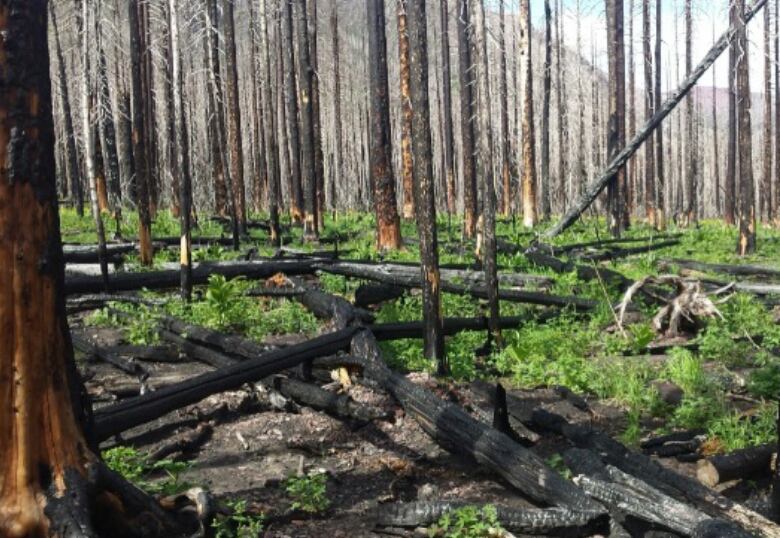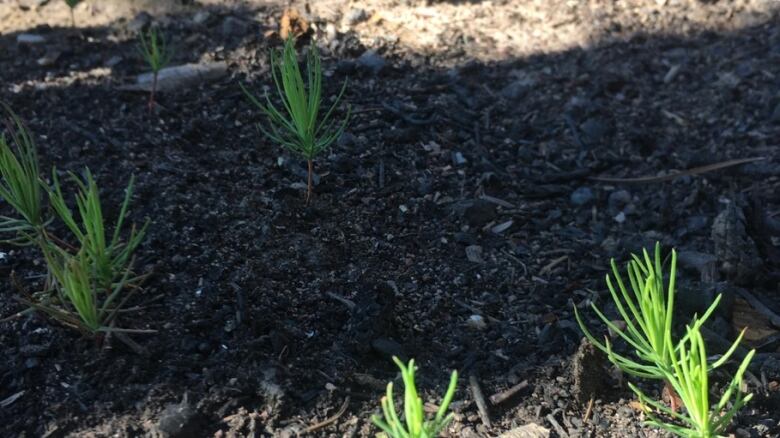Large amount of CO2 released into atmosphere during Kenow wildfire, study suggests
Soil and trees in both wet and dry climates examined to determine carbon loss

A new study from the University of Lethbridge suggests a large amountof carbon dioxide was released into the atmosphere after a wildfire burned through a large swathe of Waterton Lakes National Park nearly four years ago.
The Kenow wildfire struck the southern Alberta park in September 2017, and incinerated more than 19,000 hectares of forest and grassland, which amounted to about 40 per cent of the park.
As the fire's fourth anniversary approaches, U of L undergraduate geography student Sam Gerrand conducted a study with support from Parks Canada to quantify how much carbon was lost during the fire from soil and trees, andin both wet and dry areas of the park.

In the two300-square-metre sites Gerrand studied, he discovered thatthe riparian areas between rivers which have more organic soils to burn lost carbon equal to the annual emissions of 53 cars.
Meanwhile, the dry areas lost carbon equal to the emissions of 33 cars.
The research showed that these initial carbon losses from the soil equated to 95 per centof the long-term losses equated to standing trees.
"There haven't been many studies focused on the carbon lost from the soil, and especially in environments like we have in Waterton," Gerrand said.
"The wetareas are places where moreorganic matter would be accumulating over tens and evenhundreds of years.
"So, it might actually be the wet areas that are most susceptible to severe, deep-burningfires in the futureespecially with climate change, and summers getting drier and hotter."
Carbon released as vegetation, soil burned
The study was published in the Forest Ecology and Management journal, and is titled "Partitioning losses from fire combustion in a montane valley, Alberta Canada."
Researchers took measurementsoftrees in the park to determine how much carbon they stored, and used light detection and ranging or LiDARto createa 3D image of the earth's surfaceto help determine how much carbon was lost fromsoil.

"Trees and plants will uptake carbon dioxide from the atmosphere and store it in their vegetation structure," Gerrand said.
"So the stems of the plans and the trunks of the trees are about 50 per cent ... carbon, and every kilogram of carbon that's stored in a tree is a kilogram of carbon that's not in the atmosphere, and not contributing to climate change."
However, when vegetation and soil is burned, its stored carbon is released into the atmosphere.
"It's important to, I guess, be aware and understand our environment," Gerrand said. "And what we're doing to change the landscape."
'When will the next fire be?'
Now that researchers have an idea of how much carbon was lost, Gerrand'scolleagues are trying to figure how much carbonis coming back in the same sites and how quickly as the forest regrows.
However, if severe fires continue, and with increasing frequency, they could burn more carbon than the forest is capable of uptaking, he said.
"Within a few years, we should have an idea of whether that carbon that was lost is going to come back," Gerrand said.
"And then, it all just comes down to the question of: when will the next fire be?"
With files from Malika Karim, Wallis Snowdon and Natalie Valleau












_(720p).jpg)


 OFFICIAL HD MUSIC VIDEO.jpg)
.jpg)



























































































